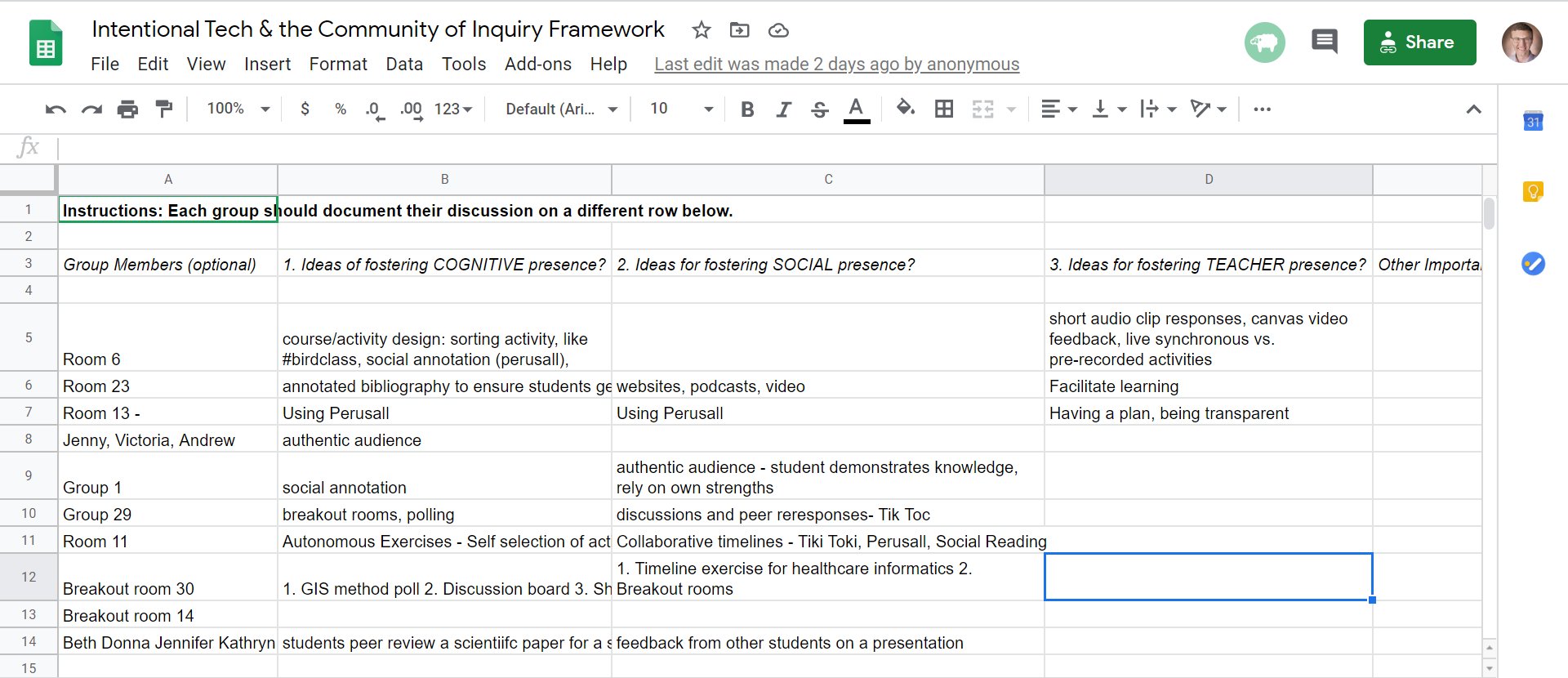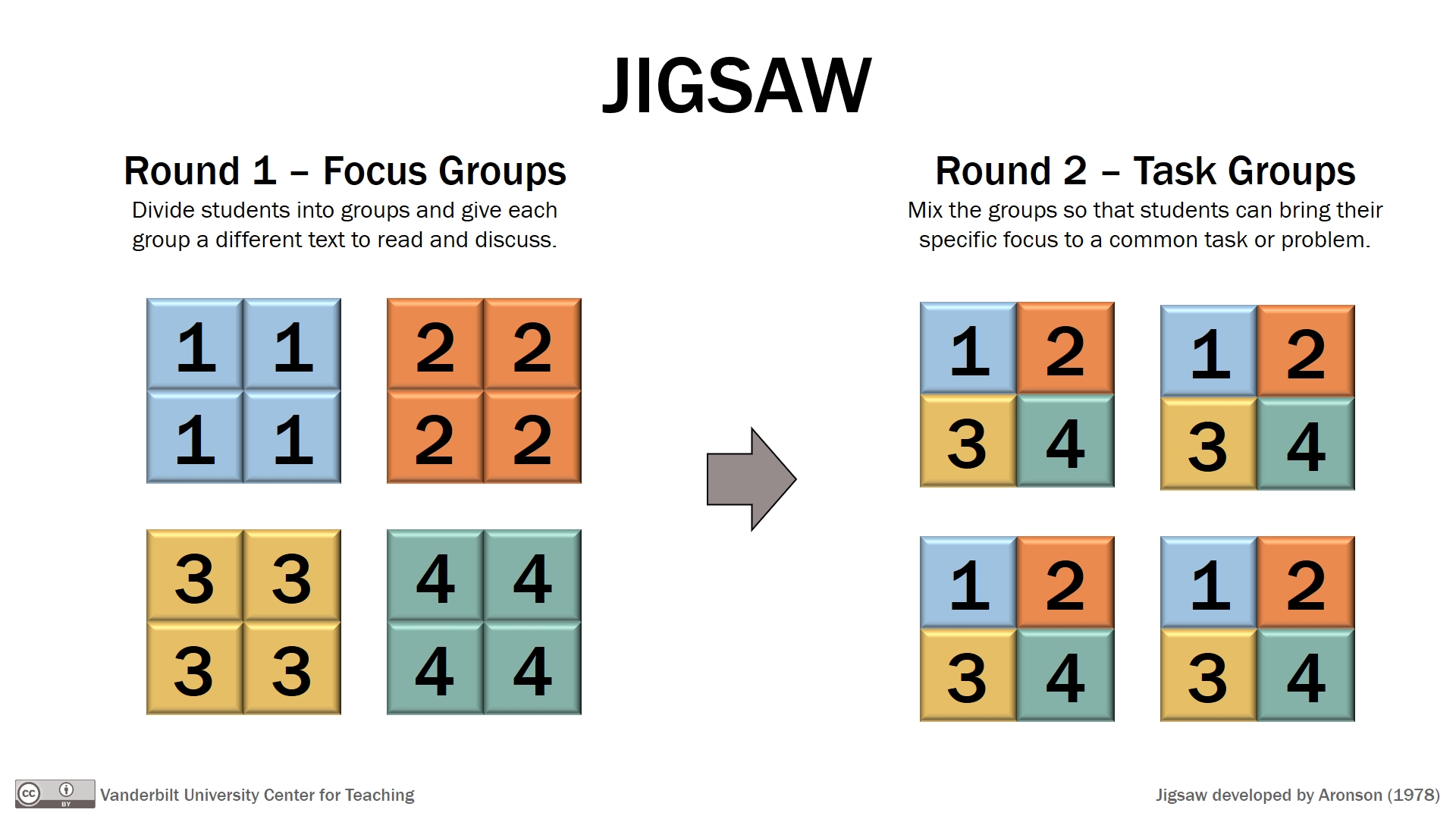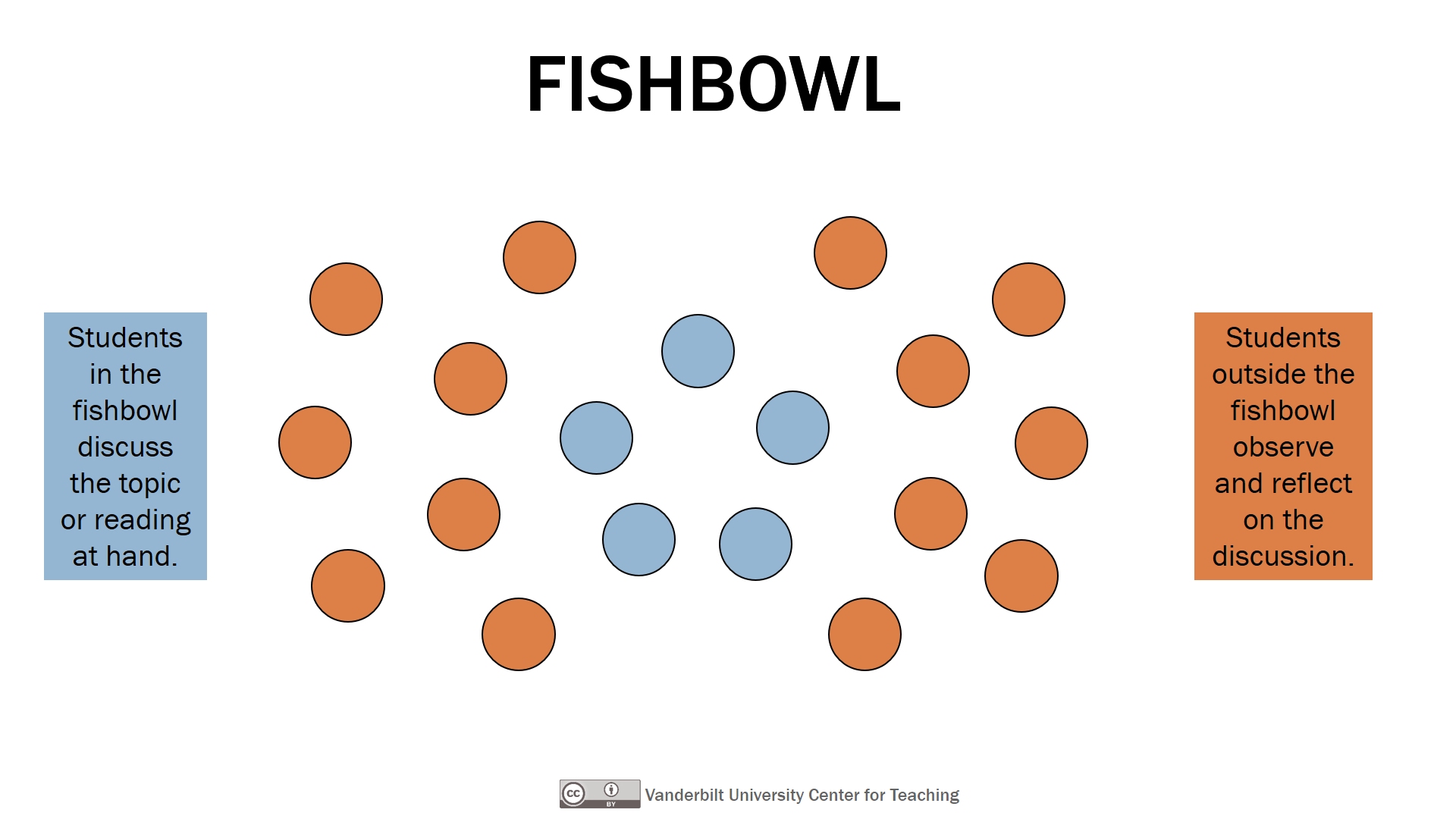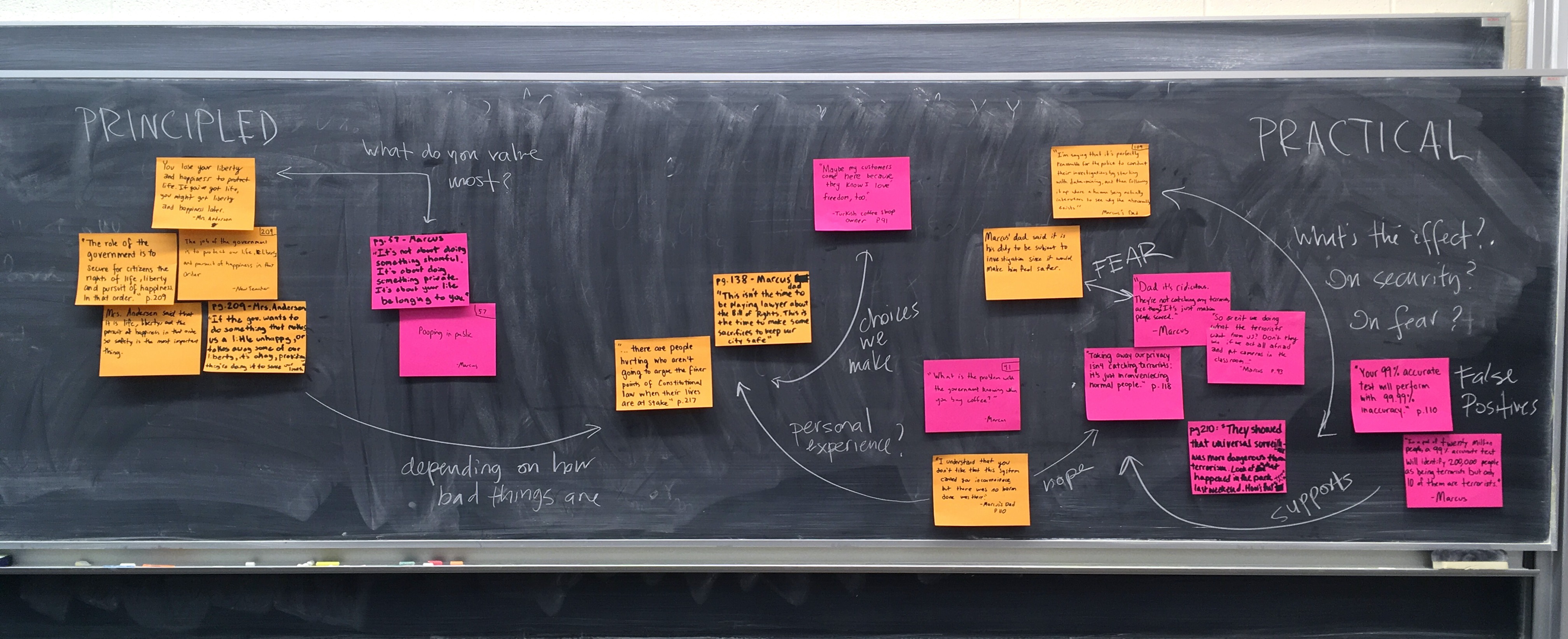Active Learning in Hybrid and Physically Distanced Classrooms
by Derek Bruff, Director
If you’ve read Norman Clark’s hypothetical day in the life of a physically distanced classroom, then you’ve probably started to worry about how faculty and other instructors might facilitate discussion, group work, and other forms of active learning this fall. If I’m standing at the front of the classroom with half or a third of my students in the room with me, but sitting six feet apart from each other and wearing masks, while the rest of my students are joining class by videoconference, what strategies might I employ to engage all of my students in meaningful learning?
I’m going to try to outline some options here in this blog post, drawing on ideas and resources from across the higher education community, but I would enthusiastically welcome additional approaches in the comments below or via Hypothesis annotations.
First, let’s take a big-picture view of fall courses on many college and university campuses this fall. We’re likely to see perhaps a handful of courses fully in-person, more courses fully online, and a significant number of courses taught in some kind of hybrid or blended fashion. See these infographics from the Office of Teaching Effectiveness and Innovation (OTEI) at Clemson University for a useful overview of options. Decisions about modalities will be made at a number of levels (department, school, university) for a number of different reasons (safety, pedagogy, student access). I’m happy to talk (elsewhere) about the pros and cons of these decisions, but for the purposes of this blog post, I’m assuming faculty have opted into or been required to teach in some blended or hybrid manner, one which will feature synchronous class sessions with a mix of in-person and online students. To be clear, I’m not arguing for classrooms structured this way; I’m just being realistic that many instructors will be facing them this fall.
I’m also assuming a few practical things:
- For instance, let’s assume that the online students are visible and audible to the in-person students, either because the instructor is projecting the videoconference on the big screen at the front of the room or because the in-person students are also logged into the videoconference, perhaps with their audio muted or on ear buds.
- I’m also assuming that all the students are able to participate synchronously. This is a pretty big assumption–it’s quite likely that there will be students who can’t participate synchronously for various reasons. How to engage those students equitably is an important conversation, but that will have to happen in a future blog post.
- And I’m assuming that in-person students have some kind of digital device (laptop, tablet, phone) they can use to participate. There are some low-tech strategies in what follows, but, in general, this is not the semester to ban digital devices in your classroom.
One more note before we look at strategies… Teaching and learning in these kinds of classrooms will be challenging. Here’s some advice from Allison Leich Hilbun, a senior lecturer in biological sciences here at Vanderbilt:
“I feel like engaging students can be helped by having honest conversations with the students about how they are feeling about this novel approach to learning. Even stopping class to ask how students feel emotionally and whether or not they feel connected could potentially help foster social connections and comfort with the new system.”
Being student-centered in our approaches to teaching means talking with our students about their experiences as learners and trying to understand and then meet their needs. Be prepared to have these conversations regularly during your course, as you and your students adapt to changing conditions.
Now, let’s talk about strategies…
Classwide Discussion
This may be one of the more challenging activities to conduct in a hybrid and socially distanced classroom. Why? It will likely be hard for the students participating virtually to hear contributions made by students participating in-person. The virtual students will presumably be able to hear the instructor through a microphone, but without extra microphones to pick up the voices of the students in the room, it’s not clear how the virtual students will hear the in-person students. Some rooms may have the audio equipment to pick up in-person students, but many classrooms won’t have that kind of gear and it’s not clear yet how well those extra mics will work for students who may be speaking through masks.
Could students in the room use their laptops or phones to participate in the videoconference? Unlikely, given some preliminary testing done by the Pepperdine University Center for Teaching Excellence. They found that having multiple people in the same room on the same videoconference led to unpleasant audio feedback. Without some more advanced hardware or an organized way to have all participants except one mute their devices, this doesn’t look like a solid option.
If you, dear reader, have ideas for conducting classwide discussions in the hybrid and socially distanced classroom, please share! In the meantime, let’s consider some other strategies.
Live Polling
One simple way to engage students in the room and on the Zoom call is to use a live polling tool to ask them questions about the course material. Back in the day, we used “clickers” for this type of live polling, but these days we have lots of options for classroom response systems. One option would be to use whatever polling feature your videoconferencing tool provides. Zoom polls, for instance, let you ask multiple-choice and multiple-mark questions pretty easily. This would mean your in-person students would need to be in the Zoom session, which has advantages. But if your Zoom screen is getting too busy, you could have your in-person students turn off their cameras; Zoom can hide participants who don’t have their cameras on.
If having your in-person students in the videoconference is hard, or if you’d like to ask more complex questions (free-response, clickable image questions, and so on), you could shift to a second platform like Poll Everywhere (free for a limited number of students) or Top Hat (free for all Vanderbilt faculty). This adds a little overhead for instructors and virtual students (now you have to manage, say, Zoom and Top Hat windows), but if you’re going to use polling regularly, that learning curve might be worth it.
What kinds of questions might you ask? Well, gosh, I wrote a book on that. But if you’d like a primer, see my 2009 essay “Multiple-Choice Questions You Wouldn’t Put on a Test,” which discusses one-best-answer questions, student perspective questions, and misconception questions, or read through my blog posts about classroom response systems.
Backchannel
The text chat that likely comes with your videoconferencing tool can be used to host what is called a backchannel for class discussion. The spoken dialog between you and your in-person or online students forms the “frontchannel,” while the text chat provides a forum for supplemental discussions among students. A backchannel can be useful for fostering dialog and even a sense of community among your in-person and online students. It can also serve some universal design purposes by providing a written alternative to spoken discussions or an ad hoc text captioning of spoken conversations.
Note that, as with live polling, if your videoconferencing tool’s built-in chat tool isn’t suitable, you could add a second platform like Slack, Discord, GroupMe, or Microsoft Teams. These platforms can also be useful outside of class time for less formal communication among students and instructors. Note also that for some videoconferencing platforms (e.g. Zoom), if a student drops the call and then re-enters the session, they lose the earlier text chat, which is another reason to use a second platform.
 Monitoring and responding to the backchannel can be a challenge for instructors, of course, whose attention can only be split so many ways. I recommend appointing someone to be the “voice of the chat.” This person could be a rotating student or a teaching assistant or a faculty colleague (maybe you can return the favor in their class). Their job is to monitor the backchannel and look for questions or comments that should be brought to the attention of the instructor. I like to plan “voice of the chat” moments in my lesson where I call on this person to speak up and share these questions and comments, and I’ll even signal these moments in my slides, using a graphic like the one seen here.
Monitoring and responding to the backchannel can be a challenge for instructors, of course, whose attention can only be split so many ways. I recommend appointing someone to be the “voice of the chat.” This person could be a rotating student or a teaching assistant or a faculty colleague (maybe you can return the favor in their class). Their job is to monitor the backchannel and look for questions or comments that should be brought to the attention of the instructor. I like to plan “voice of the chat” moments in my lesson where I call on this person to speak up and share these questions and comments, and I’ll even signal these moments in my slides, using a graphic like the one seen here.
It’s a good idea to talk with your students about how to use the backchannel productively during class sessions. You might want to establish some community norms about appropriate text chat use. You might also want to direct students’ contributions to the backchannel with some guiding questions. For some ideas, see my 2010 blog post “Backchannel in Education – Nine Uses.”
If audio is a challenge in your fall classroom, that is, if it is hard to hear students who are socially distanced and wearing masks, then the backchannel + voice of the chat combo might be particularly useful. If you have a microphone to share with your voice of the chat, you could invite all students to share their questions and comments on the backchannel, then rely on the voice of the chat to vocalize those questions with you and the entire class using the mic.
Collaborative Notetaking
A variation on the backchannel approach is collaborative notetaking. This typically involves setting up a Google Doc for students to use during class to take notes on the class discussion. Often, two or three students are appointed lead notetakers for a given class session, with that duty rotating among students over the semester, but all students are invited to read and contribute to the shared notes.
This approach provides a structure for active listening during class–notetakers don’t participate in the discussion but try to capture all of it they can, while the rest of the students can focus on participating in discussion without having to worry about taking notes–and might be particularly valuable in a classroom where it is hard to hear some students, especially if the notetakers are scattered throughout the socially distanced classroom..
Group Work
Live polling, backchannel, and collaborative notetaking are useful activities that don’t require students to leave their physical or virtual seats. But what about group work in a hybrid classroom where the in-person students aren’t free to move around the classroom? Let’s consider a possible scenario:
You have three discussion questions for your students to consider in small groups. Under normal circumstances, you might have posted these questions in a PowerPoint slide or included them in a printed handout. In your hybrid classroom, however, you’ve put your three questions at the top of a Google Sheet, one question per column. You ask your students to get into groups of two or three, with the in-person groups sitting six feet apart from each other at tables and your online students moving to breakout rooms in your videoconferencing platform. You give your students some time to discuss the questions in groups and report their answers using the Google Sheet, with each small group selecting an unused row of the spreadsheet to document their answers.
Ordinarily you might circulate among your students as they work to eavesdrop and ask a few questions. That’s not feasible now, but the Google Sheet serves a similar purpose. As the students work, you keep an eye on the sheet, monitoring your students’ progress through the activity (so you know when to call time) and getting a sense of their responses (so you can plan the debrief at the end of the activity). When the group work is over, you highlight a few student responses to share with the full group (either yourself or by asking the loudest group member to speak) along with your comments reflecting on and synthesizing the student ideas.
This approach has the advantage of engaging your in-person and online students in essentially the same activity. Your online students might actually have an easier time of it, if your in-person students find it difficult to talk at a distance and through masks. That said, having a collaborative document of some sort for the small groups to use gives them some options for handling the group conversation. For example, one group might assign each question to a different student to draft a response to, then switch up the questions for editing and revising. The coordination would happen through some simple, in-person communication, but the heavy lifting of responding would happen in the collaborative document. You might encourage group strategies like this one, if you find yourself in a classroom where students can’t hear each other well.
Of course, Google Sheets is just one option for a way to organize and share student work. Other collaborative tools (Google Docs, Google Slides) might work better for some activities. Consider also annotation tools (Hypothesis, Perusall, NowComment, VoiceThread, ReClipped), virtual whiteboards (Mural, Miro, Padlet), and spaces in your course management system. Different activities will benefit from different tools. You’ll also want to consider whether you want each group to have its own virtual space for collaboration or have all the groups work in the same virtual space.
Sometimes you might want rather structured responses from students, using something like Sheets with its columns and rows is useful, and other times you might ask more open-ended questions, asking each student group to construct its own slide in a Google Slide deck. Note that the more structure you build into the activity, the faster you’ll be able to parse and respond to student responses. In large classes, very structured options, like multiple-choice polling questions, are the most practical.
Note that moving to groups (in-person and online) and getting started using a collaborative tool will take students a little time. This isn’t as simple as turning to your neighbor in a traditional classroom and discussing a question, but if you make the group tasks meaningful and use the same tools regularly, this approach to group work has the potential to be practical.
Written Work
One note for those teaching in disciplines (like mathematics) where group work involves students seeing each other’s written work: If you’re able to equip students with individual small portable whiteboards and markers, these might make it easier for students to show their work to group members across a six-foot gap. And for students participating in group work virtually, if they’re Zooming in using their phones, they can probably point their phones at their own handwritten work when they need to share with their groups.
Hybrid Pair Work
Here’s another spin on group work: Ask your in-person students to pair up with virtual students for a quick Zoom or FaceTime call. If all the in-person students are using earbuds or headphones and if you can solve the matching problem, this might be a practical way to include pair work during class time. And it has the added benefit of fostering community across your two groups of students.
Jigsaw
Keep in mind general strategies for using group work, like the jigsaw approach. In a jigsaw, students participate in two rounds of small group activities. In the first round (sometimes called “focus groups”), each group of students is given a different reading or topic to discuss. In the second round (“task groups”), groups are reformed so that each new group has a representative from each of the first round groups. The tasks groups are then asked to bring to the conversation perspectives shared during the focus groups. In the hybrid classroom, each set of groups might be facilitated using the strategies mentioned above, and the second-round groups might be assigned intentionally so that in-person and virtual students interact.
Fishbowl
Here’s an activity that might actually work better in a hybrid classroom. The fishbowl is a class discussion strategy with a long history. In the classic formulation, an instructor would identify a small set of students who feel the same way about a topic. These students are instructed to make a circle with their chairs in the center of the room; they are in the fishbowl. They discuss the topic–how they think about it, why it’s important to them, and so on–while the rest of the students listen; the other students are outside the fishbowl. Then the instructor asks the observers to summarize or paraphrase what they heard; students in the fishbowl can affirm or clarify these remarks. Then the students switch places and repeat the process. The strategy is meant to encourage empathy for other points of view, and can be particularly useful for addressing contentious topics.
With a few modifications, the fishbowl activity should work well in the hybrid classroom. Instead of selecting students for the fishbowl by their points of view, an instructor might select a subset of their online students to be the “fish.” These students are asked to discuss the topic at hand from their various perspectives, while the other students (the in-person students and any remaining virtual students) listen and observe and (optionally) take notes in a collaborative document. After the fishbowl discussion, the observers then paraphrase or question or argue as appropriate to the topic, perhaps using their voices, the backchannel, or one of the group work structures mentioned above.
Running a fishbowl activity this way might not work as well at encouraging empathy, but it takes advantage of the fact that in a hybrid classroom the students in the room will likely have an easier time hearing the virtual students than the other way around. And if your hybrid class is structured so that you alternate which students attend in-person and which attend virtually, you can make sure that all students get the chance to be in the fishbowl over time.
Physical Movement
There’s evidence that physical movement can benefit cognitive functioning (Ferrer and Laughlin, 2017). Although the socially distanced classroom might make moving around the room difficult, there still might be ways to incorporate physical movement in classes this fall. For instance, you might supplement a yes/no or agree/disagree polling question with some vertical movement by students, e.g. stand up if you agree, sit down if you don’t. I can imagine some more colorful options here, too, like asking students who vote a certain way to dab.
Here’s another idea, assuming you can access some office supplies: During a group work activity, students could jot down ideas or questions on Post-it notes and take turns affixing their notes to a group whiteboard or chalkboard. If the sticky notes and writing utensils are large enough (I’m fond of 5” x 7” notes and Sharpies), students in the group will be able to read the collected ideas. If not, one group member could take a photo of the notes with their phone and share it with the group.
It might be hard to require movement from your virtual students, but if you have one or more in-person students taking notes on the class discussion for later sharing with the class (via a Google Doc, for instance), some of your virtual students might enjoy going for a walk while they attend class, if they are able. Planning stretch breaks into long class sessions can be useful, too.
The strategies listed above are hopefully a useful starting point for planning hybrid and socially distanced classes this fall. This isn’t meant to be a comprehensive list! We encourage you to add your ideas in the comments below or via Hypothesis annotations.
Credits: Several of the strategies and tools above, including the fishbowl activity, the ideas for physical movement, and some of the group work tools, were mentioned in the POD Network Google Group by Natalie Parker, director of the Center for Excellence in Teaching and Learning at Texas Wesleyan University. Thanks to Natalie for sharing her ideas, and to my CFT colleague Heather Fedesco for helping to expand on those ideas. Thanks also to colleagues who provided helpful comments on a draft of this piece, including Sarah Rose Cavanagh, Nancy Chick, Joshua Eyler, Christopher Heard, Karen Costa, Kelly Hogan, Aimi Hamraie, and the faculty participants in the Center for Teaching’s early-June Online Course Design Institute.





June 12th, 2020
Thanks for this excellent and very helpful post, Derek. It’s great to have these ideas in one place with very clear explanations and examples. One possible solution to the feedback issue when students in class use Zoom: ask all students in the room to turn off their speakers and their mics. A student in class who wishes to speak would turn on their mic just as a distant student would and then turn it off again when done speaking. This has the advantage of establishing the same protocol for remote and in-person participation.
Another option for your sticky note suggestion is Google Jamboard, which would allow students in class and remotely to post virtual stickies (or freehand drawings) and possibly work collaboratively to organize them.
Thanks again, Derek!
Matt
June 12th, 2020
Thanks for this post! We are trying to plan for active learning online in the fall. Bob Sachs sent me this blog and I had some reflections about how this move impacts my traditional teaching.
For written work, we’re evaluating collaborative whiteboard spaces now, like awwapp and limnu for use in our active learning online math courses. Built-in whiteboards in Blackboard and zoom have some limitations. Some of the whiteboards (like awwapp ) stay live long after class is over. Students can reference the work they did with fellow students later. This allows students to concentrate on collaboration instead of notetaking during groupwork. I ended up creating a reflective assignment at the end of the course, asking students to go back through and reflect on the synchronous group work.
We have had some institutional concerns about FERPA compliance for these nice online tools, so we are trying to address that this summer.
June 17th, 2020
Thanks very much! These are some of the best ideas I’ve seen yet for adding value to socially distanced classrooms. I especially like the “Voice of the Chat” and the Collaborative Notetaking.
June 24th, 2020
This is a wonderful resource–thank you so much. I’m wondering whether you or others in the forum have any further suggestions or readings specific to teaching language in hybrid and physically distanced classrooms? My colleagues and I are struggling with creatively meeting the challenge of teaching with masks or face shields on to masked/shielded students in-person while simultaneously teaching via zoom. Thank you.
June 26th, 2020
I used a lot of these ideas when we went fully remote last spring. So why have the students in the classroom at all?
June 26th, 2020
These are nice ideas, many of which I used in the spring when we were fully online. But I really don’t see the point of the students being there physically then. If you’re all on Zoom, why are some students in the physical classroom? What’s the benefit? It seems like there’s only drawbacks. Why can’t everyone just join on Zoom from wherever? And then I think there would be more equity in attention from the instructor, if everyone was in the same mode.
June 28th, 2020
None of those procedures would be suitable for my lectures, but some would be useful for discussion sections, which will meet once a week.